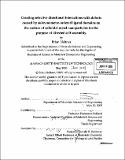Creating selective directional interactions with defects caused by subnanometre-ordered ligand domains on the surface of colloidal metal nanoparticles for the purpose of directed self-assembly
Author(s)
Neltner, Brian
DownloadFull printable version (3.116Mb)
Other Contributors
Massachusetts Institute of Technology. Dept. of Materials Science and Engineering.
Advisor
Francesco Stellacci.
Terms of use
Metadata
Show full item recordAbstract
Introduction: The ability to utilize directional, specific bonds are a fundamental property of atoms which has allowed us to predictably create molecules of consistent geometry and composition for centuries. One fundamental difference between a true atom and a nanoparticle is that to date, nanoparticles do not possess this property.
Description
Thesis (S.B.)--Massachusetts Institute of Technology, Dept. of Materials Science and Engineering, 2005. Includes bibliographical references (p. 42-43).
Date issued
2005Department
Massachusetts Institute of Technology. Department of Materials Science and EngineeringPublisher
Massachusetts Institute of Technology
Keywords
Materials Science and Engineering.